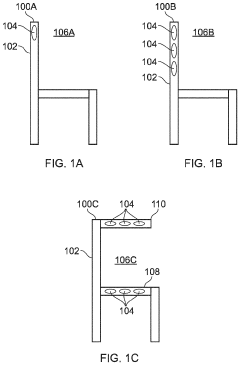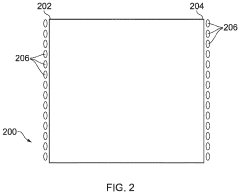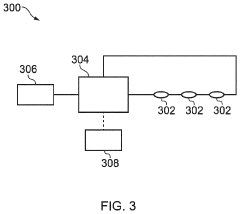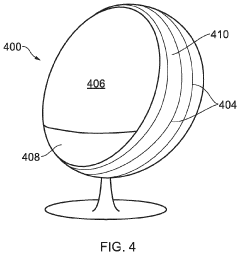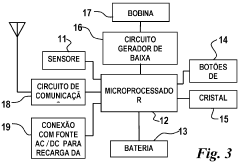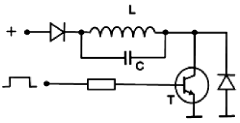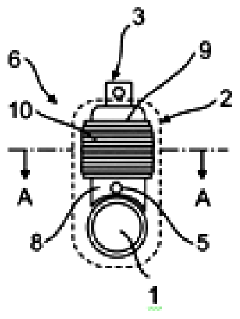How to Explore Schumann Resonance in Technological Contexts?
JUN 24, 20259 MIN READ
Generate Your Research Report Instantly with AI Agent
Patsnap Eureka helps you evaluate technical feasibility & market potential.
Schumann Resonance Background and Objectives
Schumann resonance, discovered by physicist Winfried Otto Schumann in 1952, refers to the natural electromagnetic frequencies occurring in the Earth's ionosphere. These resonances, typically around 7.83 Hz, are generated by global lightning activity and have been a subject of scientific interest for decades. The exploration of Schumann resonance in technological contexts has gained momentum in recent years, driven by advancements in sensing technologies and the growing interest in Earth-ionosphere interactions.
The evolution of Schumann resonance research has been marked by significant milestones. Initially observed as a theoretical concept, it was later confirmed through experimental measurements. The development of more sensitive magnetometers and advanced signal processing techniques has greatly enhanced our ability to detect and analyze these resonances. This progress has opened up new avenues for technological applications, ranging from global lightning detection systems to potential biomedical devices.
The primary objective in exploring Schumann resonance within technological contexts is to harness its unique properties for practical applications. One key goal is to develop more accurate global weather monitoring systems by leveraging the relationship between Schumann resonances and lightning activity. Another objective is to investigate potential health implications, as some researchers hypothesize a connection between these resonances and human physiological rhythms.
In the realm of communications, there is growing interest in utilizing Schumann resonances for long-range, low-frequency signal transmission. This could potentially lead to the development of novel communication systems that are less susceptible to traditional electromagnetic interference. Additionally, researchers aim to explore the use of Schumann resonances in geophysical prospecting and earthquake prediction models.
The technological exploration of Schumann resonances also extends to the field of renewable energy. Some scientists are investigating the possibility of tapping into these natural electromagnetic oscillations as a source of clean energy, although this remains a highly speculative area of research. Furthermore, there is ongoing work to integrate Schumann resonance monitoring into global climate models to enhance our understanding of Earth's electromagnetic environment and its potential impacts on climate systems.
As we look towards the future, the technological exploration of Schumann resonances is expected to intersect with emerging fields such as quantum sensing and artificial intelligence. These intersections could potentially lead to breakthroughs in ultra-sensitive detection methods and more sophisticated data analysis techniques, further expanding the practical applications of this fascinating natural phenomenon.
The evolution of Schumann resonance research has been marked by significant milestones. Initially observed as a theoretical concept, it was later confirmed through experimental measurements. The development of more sensitive magnetometers and advanced signal processing techniques has greatly enhanced our ability to detect and analyze these resonances. This progress has opened up new avenues for technological applications, ranging from global lightning detection systems to potential biomedical devices.
The primary objective in exploring Schumann resonance within technological contexts is to harness its unique properties for practical applications. One key goal is to develop more accurate global weather monitoring systems by leveraging the relationship between Schumann resonances and lightning activity. Another objective is to investigate potential health implications, as some researchers hypothesize a connection between these resonances and human physiological rhythms.
In the realm of communications, there is growing interest in utilizing Schumann resonances for long-range, low-frequency signal transmission. This could potentially lead to the development of novel communication systems that are less susceptible to traditional electromagnetic interference. Additionally, researchers aim to explore the use of Schumann resonances in geophysical prospecting and earthquake prediction models.
The technological exploration of Schumann resonances also extends to the field of renewable energy. Some scientists are investigating the possibility of tapping into these natural electromagnetic oscillations as a source of clean energy, although this remains a highly speculative area of research. Furthermore, there is ongoing work to integrate Schumann resonance monitoring into global climate models to enhance our understanding of Earth's electromagnetic environment and its potential impacts on climate systems.
As we look towards the future, the technological exploration of Schumann resonances is expected to intersect with emerging fields such as quantum sensing and artificial intelligence. These intersections could potentially lead to breakthroughs in ultra-sensitive detection methods and more sophisticated data analysis techniques, further expanding the practical applications of this fascinating natural phenomenon.
Market Applications of Schumann Resonance
Schumann Resonance, a natural electromagnetic phenomenon occurring in the Earth's ionosphere, has gained significant attention in various technological contexts. The market applications of this phenomenon span across multiple sectors, offering innovative solutions and potential advancements in diverse fields.
In the realm of health and wellness, Schumann Resonance has found applications in the development of therapeutic devices. These devices aim to synchronize human brainwaves with the Earth's natural frequency, potentially promoting relaxation, stress reduction, and overall well-being. The market for such devices has seen steady growth, particularly among individuals seeking alternative approaches to mental health and stress management.
Environmental monitoring represents another promising market application of Schumann Resonance. By analyzing variations in the resonance patterns, researchers and environmental agencies can gain insights into global climate changes, atmospheric conditions, and even seismic activities. This application has led to the development of specialized monitoring equipment and data analysis tools, creating a niche market within the environmental technology sector.
In the field of telecommunications, Schumann Resonance has inspired novel approaches to long-range communication systems. By leveraging the Earth's natural electromagnetic cavity, researchers are exploring ways to enhance signal propagation and develop more efficient, low-frequency communication technologies. This research has potential applications in remote area communications, underwater communications, and even in space exploration.
The aerospace industry has also shown interest in Schumann Resonance applications. Some researchers propose using the phenomenon for navigation and positioning systems, potentially complementing or enhancing existing GPS technologies. This could lead to the development of more robust navigation systems for aircraft and spacecraft, opening up new market opportunities in the aerospace sector.
In agriculture, Schumann Resonance is being explored for its potential effects on plant growth and crop yields. Some studies suggest that exposure to these natural frequencies may influence plant physiology and growth patterns. This has led to the development of experimental agricultural technologies aimed at optimizing crop production through controlled electromagnetic environments.
The energy sector is another area where Schumann Resonance finds potential applications. Researchers are investigating the possibility of harnessing this natural electromagnetic energy as a renewable power source. While still in early stages, this concept could potentially lead to the development of novel energy harvesting technologies and contribute to the growing market for alternative energy solutions.
As these market applications continue to evolve, they are driving demand for specialized measurement equipment, data analysis software, and research tools related to Schumann Resonance. This has created a growing niche market for scientific instruments and analytical services catering to researchers, industries, and government agencies interested in exploring and utilizing this natural phenomenon.
In the realm of health and wellness, Schumann Resonance has found applications in the development of therapeutic devices. These devices aim to synchronize human brainwaves with the Earth's natural frequency, potentially promoting relaxation, stress reduction, and overall well-being. The market for such devices has seen steady growth, particularly among individuals seeking alternative approaches to mental health and stress management.
Environmental monitoring represents another promising market application of Schumann Resonance. By analyzing variations in the resonance patterns, researchers and environmental agencies can gain insights into global climate changes, atmospheric conditions, and even seismic activities. This application has led to the development of specialized monitoring equipment and data analysis tools, creating a niche market within the environmental technology sector.
In the field of telecommunications, Schumann Resonance has inspired novel approaches to long-range communication systems. By leveraging the Earth's natural electromagnetic cavity, researchers are exploring ways to enhance signal propagation and develop more efficient, low-frequency communication technologies. This research has potential applications in remote area communications, underwater communications, and even in space exploration.
The aerospace industry has also shown interest in Schumann Resonance applications. Some researchers propose using the phenomenon for navigation and positioning systems, potentially complementing or enhancing existing GPS technologies. This could lead to the development of more robust navigation systems for aircraft and spacecraft, opening up new market opportunities in the aerospace sector.
In agriculture, Schumann Resonance is being explored for its potential effects on plant growth and crop yields. Some studies suggest that exposure to these natural frequencies may influence plant physiology and growth patterns. This has led to the development of experimental agricultural technologies aimed at optimizing crop production through controlled electromagnetic environments.
The energy sector is another area where Schumann Resonance finds potential applications. Researchers are investigating the possibility of harnessing this natural electromagnetic energy as a renewable power source. While still in early stages, this concept could potentially lead to the development of novel energy harvesting technologies and contribute to the growing market for alternative energy solutions.
As these market applications continue to evolve, they are driving demand for specialized measurement equipment, data analysis software, and research tools related to Schumann Resonance. This has created a growing niche market for scientific instruments and analytical services catering to researchers, industries, and government agencies interested in exploring and utilizing this natural phenomenon.
Current State and Challenges in Schumann Resonance Research
Schumann resonance research has made significant strides in recent years, yet it continues to face several challenges in both theoretical understanding and practical applications. Currently, the field is characterized by a growing interest in exploring the potential of Schumann resonances in various technological contexts, particularly in areas such as global climate monitoring, earthquake prediction, and human health.
One of the primary challenges in Schumann resonance research is the difficulty in isolating and measuring these extremely low-frequency electromagnetic waves amidst the noise of modern electromagnetic environments. Researchers are developing increasingly sophisticated detection and filtering techniques to address this issue, but achieving consistent and reliable measurements remains a significant hurdle.
The global network of Schumann resonance monitoring stations has expanded, providing more comprehensive data. However, the distribution of these stations is still uneven, with gaps in coverage over large oceanic areas and certain continents. This limitation hampers our ability to create a truly global picture of Schumann resonance phenomena and their variations.
Advancements in data analysis and modeling have improved our understanding of the complex interactions between Schumann resonances and various geophysical and atmospheric processes. Machine learning algorithms are being employed to identify subtle patterns and correlations in the data. Nevertheless, the multifaceted nature of these interactions presents ongoing challenges in interpretation and prediction.
The potential applications of Schumann resonance in technological contexts are expanding. Researchers are exploring its use in long-range communication systems, particularly for underwater or underground environments where traditional radio waves are ineffective. However, the practical implementation of such systems faces challenges related to signal strength, reliability, and interference.
In the realm of health sciences, studies investigating the effects of Schumann resonances on human physiology and cognition are gaining traction. While some research suggests potential benefits, such as improved sleep quality and reduced stress, the scientific community remains divided on the validity and reproducibility of these findings. Rigorous, large-scale studies are needed to establish conclusive evidence.
The integration of Schumann resonance data with other geophysical and meteorological datasets presents both opportunities and challenges. While this integration could potentially enhance our understanding of global climate systems and improve forecasting models, it requires sophisticated data fusion techniques and interdisciplinary collaboration.
As research progresses, there is a growing need for standardization in measurement protocols and data reporting to ensure comparability of results across different studies and locations. The development of such standards is an ongoing process that requires consensus among the international scientific community.
One of the primary challenges in Schumann resonance research is the difficulty in isolating and measuring these extremely low-frequency electromagnetic waves amidst the noise of modern electromagnetic environments. Researchers are developing increasingly sophisticated detection and filtering techniques to address this issue, but achieving consistent and reliable measurements remains a significant hurdle.
The global network of Schumann resonance monitoring stations has expanded, providing more comprehensive data. However, the distribution of these stations is still uneven, with gaps in coverage over large oceanic areas and certain continents. This limitation hampers our ability to create a truly global picture of Schumann resonance phenomena and their variations.
Advancements in data analysis and modeling have improved our understanding of the complex interactions between Schumann resonances and various geophysical and atmospheric processes. Machine learning algorithms are being employed to identify subtle patterns and correlations in the data. Nevertheless, the multifaceted nature of these interactions presents ongoing challenges in interpretation and prediction.
The potential applications of Schumann resonance in technological contexts are expanding. Researchers are exploring its use in long-range communication systems, particularly for underwater or underground environments where traditional radio waves are ineffective. However, the practical implementation of such systems faces challenges related to signal strength, reliability, and interference.
In the realm of health sciences, studies investigating the effects of Schumann resonances on human physiology and cognition are gaining traction. While some research suggests potential benefits, such as improved sleep quality and reduced stress, the scientific community remains divided on the validity and reproducibility of these findings. Rigorous, large-scale studies are needed to establish conclusive evidence.
The integration of Schumann resonance data with other geophysical and meteorological datasets presents both opportunities and challenges. While this integration could potentially enhance our understanding of global climate systems and improve forecasting models, it requires sophisticated data fusion techniques and interdisciplinary collaboration.
As research progresses, there is a growing need for standardization in measurement protocols and data reporting to ensure comparability of results across different studies and locations. The development of such standards is an ongoing process that requires consensus among the international scientific community.
Existing Methods for Schumann Resonance Detection
01 Schumann resonance devices for health and wellness
Various devices are designed to generate or utilize Schumann resonance frequencies for potential health benefits. These devices aim to simulate the natural electromagnetic frequencies of the Earth to promote relaxation, improve sleep quality, and enhance overall well-being. Some implementations include wearable devices, room-based generators, and portable units that emit Schumann resonance frequencies.- Schumann resonance generators and devices: Various devices and generators are designed to produce or simulate Schumann resonances. These devices may be used for therapeutic purposes, environmental enhancement, or research applications. They often incorporate electromagnetic field generators and may include features for adjusting frequency and intensity.
- Wearable Schumann resonance devices: Wearable devices that incorporate Schumann resonance technology have been developed. These may include accessories like bracelets, necklaces, or other personal items designed to expose the wearer to Schumann resonance frequencies. Such devices aim to provide potential health benefits or enhance well-being.
- Schumann resonance in therapeutic applications: Schumann resonance is being explored for various therapeutic applications. This includes its potential use in stress reduction, improving sleep quality, enhancing meditation practices, and general health improvement. Devices and methods are being developed to apply Schumann resonance in medical and wellness settings.
- Integration of Schumann resonance in living spaces: Efforts are being made to incorporate Schumann resonance technology into living and working environments. This includes the development of room-scale generators, building materials, or furniture that can produce or enhance Schumann resonance frequencies, potentially creating more harmonious and health-promoting spaces.
- Schumann resonance measurement and analysis tools: Specialized equipment and methods for measuring, analyzing, and monitoring Schumann resonances are being developed. These tools may be used for scientific research, environmental monitoring, or as part of larger systems that utilize Schumann resonance data for various applications.
02 Schumann resonance in environmental monitoring and prediction
Schumann resonance measurements are used in environmental monitoring systems to detect and analyze atmospheric phenomena. These systems can potentially predict natural disasters, monitor climate changes, and provide early warning for severe weather events. The technology involves sensors and data processing algorithms to interpret Schumann resonance signals for environmental applications.Expand Specific Solutions03 Integration of Schumann resonance in electronic devices
Electronic devices, including smartphones, tablets, and wearables, are being designed to incorporate Schumann resonance technology. These devices may include built-in generators or receivers to provide users with the potential benefits of Schumann resonance exposure in their daily lives. The integration aims to counteract the effects of artificial electromagnetic fields from modern technology.Expand Specific Solutions04 Schumann resonance in agriculture and plant growth
Applications of Schumann resonance in agriculture focus on improving plant growth and crop yields. Systems are designed to expose plants to Schumann resonance frequencies, potentially enhancing their natural growth processes, resistance to pests, and overall health. This technology may be implemented in greenhouses, vertical farming systems, and traditional agricultural settings.Expand Specific Solutions05 Schumann resonance-based therapeutic devices
Therapeutic devices utilizing Schumann resonance frequencies are being developed for various medical applications. These devices aim to provide non-invasive treatments for conditions such as stress, anxiety, sleep disorders, and pain management. The technology may include specialized beds, chairs, or portable units that emit controlled Schumann resonance frequencies for therapeutic purposes.Expand Specific Solutions
Key Players in Schumann Resonance Technology
The exploration of Schumann Resonance in technological contexts is in its early stages, with a growing market driven by potential applications in various fields. The technology's maturity is still developing, as evidenced by the diverse range of companies involved. Major players like IBM, Intel, and Microsoft are investing in research, indicating significant potential. Universities such as Boston University and Xiamen University are contributing to fundamental research. Electronics giants Samsung and Philips are exploring practical applications, while specialized firms like Rohde & Schwarz focus on measurement technologies. The involvement of defense-related entities like Raytheon and the National University of Defense Technology suggests strategic importance. Overall, the field is characterized by a mix of academic research, corporate R&D, and emerging commercial applications, with ample room for innovation and market growth.
Intel Corp.
Technical Solution: Intel's approach to exploring Schumann Resonance in technological contexts focuses on developing specialized hardware and software solutions. They have created a series of low-power, high-sensitivity electromagnetic sensors based on their advanced semiconductor technology. These sensors are designed to be integrated into existing IoT devices and smart city infrastructure, creating a widespread network for Schumann Resonance detection. Intel's solution also includes a dedicated edge computing platform that processes the sensor data locally, reducing latency and bandwidth requirements. Their AI-powered analytics software runs on this platform, enabling real-time analysis of Schumann Resonance patterns and their potential correlations with various environmental and technological phenomena.
Strengths: Leveraging existing IoT infrastructure, energy-efficient sensor design, and powerful edge computing capabilities. Weaknesses: Dependence on widespread adoption of Intel's hardware solutions and potential interference from other electromagnetic sources in urban environments.
Samsung Electronics Co., Ltd.
Technical Solution: Samsung's technological approach to exploring Schumann Resonance involves integrating ultra-sensitive electromagnetic sensors into their wide range of consumer electronics and smart home devices. By leveraging their extensive product ecosystem, Samsung aims to create a vast, distributed network of Schumann Resonance detection points. Their solution includes specially designed software that runs on Samsung smartphones and smart TVs, allowing users to participate in crowd-sourced Schumann Resonance data collection. The company has also developed a cloud-based platform that aggregates and analyzes the collected data, providing insights into potential applications such as weather prediction, health monitoring, and electromagnetic pollution assessment.
Strengths: Extensive consumer device network, user-friendly interface for data collection, and potential for large-scale citizen science projects. Weaknesses: Variability in data quality due to diverse device locations and potential privacy concerns regarding data collection.
Core Innovations in Schumann Resonance Utilization
A magnetic field exposure system and uses thereof
PatentPendingUS20230372726A1
Innovation
- A magnetic field exposure system generating an amplitude-modulated low frequency magnetic field with a carrier frequency of 360 to 450 Hz and a modulation frequency of 0.5 to 100 Hz, providing a field strength of 0.5 to 250 μT, specifically designed to enhance cell survival, proliferation, reduce stress, and promote tissue regeneration.
ULTRA LOW FREQUENCIES generator INCLUDING SCHUMANN FREQUENCIES IN A WEARABLE DEVICE
PatentPendingBR102019020200A2
Innovation
- Integration of ultra-low frequency generator, including Schumann frequencies, into a wearable device.
- Customizable frequency generation with pre-established sequences and intervals controlled by a specific application.
- Dual control options: autonomous operation through resident software or remote control via radiofrequency link with smartphones, tablets, or computers.
Environmental Factors Affecting Schumann Resonance
The Schumann resonance, a set of spectral peaks in the Earth's electromagnetic field spectrum, is significantly influenced by various environmental factors. These factors play a crucial role in shaping the characteristics and behavior of the resonance, making their understanding essential for technological applications.
Atmospheric conditions are among the primary environmental factors affecting Schumann resonance. The ionosphere, a layer of charged particles in the upper atmosphere, acts as a waveguide for electromagnetic waves. Changes in the ionosphere's composition and height due to solar activity, geomagnetic storms, and day-night cycles can alter the propagation of these waves, thereby affecting the resonance frequency and amplitude.
Lightning activity is another critical factor. As the primary source of excitation for Schumann resonance, global lightning distribution and intensity directly impact the resonance's strength and variability. Seasonal changes in lightning patterns, particularly in tropical regions, can lead to noticeable fluctuations in Schumann resonance measurements.
Geomagnetic field variations also play a significant role. The Earth's magnetic field interacts with the electromagnetic waves that constitute the Schumann resonance. Geomagnetic storms and other disturbances can cause shifts in the resonance frequency and amplitude, potentially affecting technological applications relying on these signals.
Climate change and its associated phenomena have emerged as increasingly important factors. Rising global temperatures can alter atmospheric conductivity and lightning patterns, potentially leading to long-term changes in Schumann resonance characteristics. Extreme weather events, which are becoming more frequent due to climate change, can cause short-term disturbances in the resonance.
Human activities also contribute to environmental factors affecting Schumann resonance. Urbanization and industrial development lead to increased electromagnetic noise, potentially interfering with Schumann resonance measurements. Additionally, large-scale changes in land use, such as deforestation, can alter local atmospheric conditions and potentially impact the global electromagnetic environment.
Understanding these environmental factors is crucial for developing robust technological applications that utilize or monitor Schumann resonance. It enables researchers and engineers to account for natural variations and potential disturbances, ensuring more accurate and reliable results in fields such as global lightning detection, earthquake prediction, and atmospheric science.
Atmospheric conditions are among the primary environmental factors affecting Schumann resonance. The ionosphere, a layer of charged particles in the upper atmosphere, acts as a waveguide for electromagnetic waves. Changes in the ionosphere's composition and height due to solar activity, geomagnetic storms, and day-night cycles can alter the propagation of these waves, thereby affecting the resonance frequency and amplitude.
Lightning activity is another critical factor. As the primary source of excitation for Schumann resonance, global lightning distribution and intensity directly impact the resonance's strength and variability. Seasonal changes in lightning patterns, particularly in tropical regions, can lead to noticeable fluctuations in Schumann resonance measurements.
Geomagnetic field variations also play a significant role. The Earth's magnetic field interacts with the electromagnetic waves that constitute the Schumann resonance. Geomagnetic storms and other disturbances can cause shifts in the resonance frequency and amplitude, potentially affecting technological applications relying on these signals.
Climate change and its associated phenomena have emerged as increasingly important factors. Rising global temperatures can alter atmospheric conductivity and lightning patterns, potentially leading to long-term changes in Schumann resonance characteristics. Extreme weather events, which are becoming more frequent due to climate change, can cause short-term disturbances in the resonance.
Human activities also contribute to environmental factors affecting Schumann resonance. Urbanization and industrial development lead to increased electromagnetic noise, potentially interfering with Schumann resonance measurements. Additionally, large-scale changes in land use, such as deforestation, can alter local atmospheric conditions and potentially impact the global electromagnetic environment.
Understanding these environmental factors is crucial for developing robust technological applications that utilize or monitor Schumann resonance. It enables researchers and engineers to account for natural variations and potential disturbances, ensuring more accurate and reliable results in fields such as global lightning detection, earthquake prediction, and atmospheric science.
Potential Health Implications of Schumann Resonance
The potential health implications of Schumann Resonance have garnered increasing attention in recent years, particularly in the context of technological advancements. Schumann Resonance, a set of spectrum peaks in the extremely low frequency (ELF) portion of the Earth's electromagnetic field, has been hypothesized to influence various aspects of human health and well-being.
Research has suggested that exposure to Schumann Resonance frequencies may have positive effects on human physiology. Some studies indicate that these frequencies could potentially enhance relaxation, improve sleep quality, and reduce stress levels. The resonance has been linked to the regulation of circadian rhythms, which play a crucial role in maintaining overall health and cognitive function.
Furthermore, there is growing interest in the potential therapeutic applications of Schumann Resonance. Some researchers propose that controlled exposure to these frequencies could be beneficial in treating certain health conditions, such as mood disorders, chronic pain, and inflammatory diseases. However, it is important to note that much of this research is still in its early stages, and more rigorous scientific studies are needed to establish definitive health benefits.
On the other hand, concerns have been raised about the potential negative health effects of artificial electromagnetic fields that may interfere with natural Schumann Resonance. The proliferation of wireless technologies and electronic devices has led to an increase in man-made electromagnetic radiation, which some experts believe could disrupt the body's natural electromagnetic balance.
As technological exploration of Schumann Resonance continues, it is crucial to consider both the potential benefits and risks. Future research should focus on developing methods to accurately measure and replicate Schumann Resonance frequencies in controlled environments. This could lead to the development of novel therapeutic devices or techniques that harness the potential health benefits of these natural electromagnetic frequencies.
Additionally, investigating the long-term effects of exposure to artificial electromagnetic fields and their interaction with Schumann Resonance is essential. This research could inform the development of guidelines for electromagnetic hygiene and the design of technologies that minimize potential negative health impacts while maximizing the benefits of natural electromagnetic frequencies.
Research has suggested that exposure to Schumann Resonance frequencies may have positive effects on human physiology. Some studies indicate that these frequencies could potentially enhance relaxation, improve sleep quality, and reduce stress levels. The resonance has been linked to the regulation of circadian rhythms, which play a crucial role in maintaining overall health and cognitive function.
Furthermore, there is growing interest in the potential therapeutic applications of Schumann Resonance. Some researchers propose that controlled exposure to these frequencies could be beneficial in treating certain health conditions, such as mood disorders, chronic pain, and inflammatory diseases. However, it is important to note that much of this research is still in its early stages, and more rigorous scientific studies are needed to establish definitive health benefits.
On the other hand, concerns have been raised about the potential negative health effects of artificial electromagnetic fields that may interfere with natural Schumann Resonance. The proliferation of wireless technologies and electronic devices has led to an increase in man-made electromagnetic radiation, which some experts believe could disrupt the body's natural electromagnetic balance.
As technological exploration of Schumann Resonance continues, it is crucial to consider both the potential benefits and risks. Future research should focus on developing methods to accurately measure and replicate Schumann Resonance frequencies in controlled environments. This could lead to the development of novel therapeutic devices or techniques that harness the potential health benefits of these natural electromagnetic frequencies.
Additionally, investigating the long-term effects of exposure to artificial electromagnetic fields and their interaction with Schumann Resonance is essential. This research could inform the development of guidelines for electromagnetic hygiene and the design of technologies that minimize potential negative health impacts while maximizing the benefits of natural electromagnetic frequencies.
Unlock deeper insights with Patsnap Eureka Quick Research — get a full tech report to explore trends and direct your research. Try now!
Generate Your Research Report Instantly with AI Agent
Supercharge your innovation with Patsnap Eureka AI Agent Platform!
